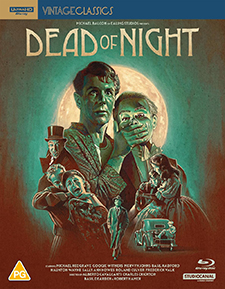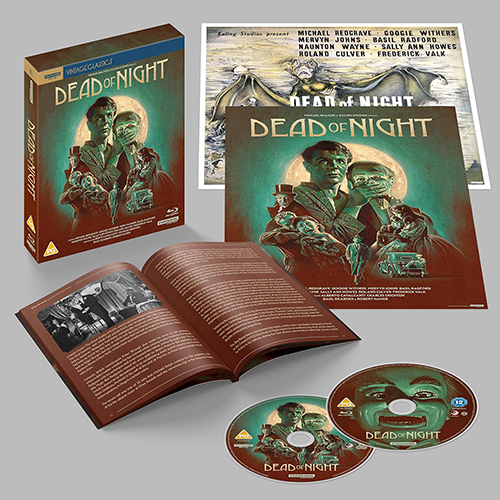Dead of Night: 80th Anniversary Collector's Edition (4K UHD Review)

Director
Alberto Cavalcanti, Charles Crichton, Basil Dearden, Robert HamerRelease Date(s)
1945 (October 20, 2025)Studio(s)
Ealing Studios/Universal Pictures (StudioCanal)- Film/Program Grade: B
- Video Grade: A-
- Audio Grade: B+
- Extras Grade: B
Review
[Editor’s Note: We have been provided with a check disc of the 4K Ultra HD only for this release. It’s a Region-Free British 4K import with a Region B-locked Blu-ray disc.]
Horror anthologies have been popular with genre fans for decades, solidifying in the 1970s with Amicus Productions and their releases of Dr. Terror’s House of Horrors, Tales from the Crypt, Asylum, From Beyond the Grave, and many others. Prior to that, portmanteau films were not at all common, and few were horror-based. 1945’s Dead of Night certainly birthed what we think of as the horror anthology, which has been celebrated by critics and fans as one of the best ever produced, and influencing Milton Subotsky and Max J. Rosenberg of Amicus Productions.
Directed by Alberto Cavalcanti, Charles Crichton, Robert Hamer, and Basil Dearden, the five stories that it includes, as well as the wraparound, are much more integrated with each other than many other anthologies. In the film, an architect named Walter Craig (Mervyn Johns) arrives at an English farmhouse for a possible job. Once he settles in and meets the guests who are staying there, he realizes that he has dreamed about all of them and this entire visit before, knowing exactly what will transpire between them. As the other guests discuss whether Mr. Craig’s convictions have any validity, they share their own supernatural tales.
In the first, Hugh (Anthony Baird) tells of the time he spent in the hospital after crashing his racing car, falling in love with his nurse Judy (Joyce Grainger), and being haunted by a hearse driver outside his window saying “just room for one inside, sir.” In the second, young Sally (Sally Ann Howes) recalls a Christmas party at a large mansion in which her and the other children played a game of hide-and-seek, whereupon she discovered a crying young child whom she comforted. In the third, the newly-married Joan (Googie Withers) buys her husband Peter (Ralph Michael) an antique mirror for his birthday, not knowing that it has supernatural qualities and was previously owned by an adulterous murderer, subsequently having an unusual effect on Peter when he looks into it. In the fourth, Eliot (Roland Culver) recounts the story of two friends, George (Basil Radford) and Larry (Naunton Wayne), who wager over a round of golf for the hand of the beautiful Peggy (Mary Lee) in marriage. After his loss, Larry drowns himself, only to come back to comically haunt George. In the fifth and final story, psychiatrist Dr. van Straaten (Frederick Valk) remembers a case involving the ventriloquist Maxwell (Michael Redgrave) and his dummy Hugo. Fellow ventriloquist Sylvester (Hartley Power) comes to see their show, but things begin to go awry when Hugo expresses his desire to leave Maxwell for Sylvester.
While the whole of Dead of Night is very well shot and mostly works, it’s the final segment and the outcome of the framing story that truly give the film its staying power. The Christmas party and the ghostly golfer stories are the weakest of the five, with the latter going more for an overtly comedic tone than a dread-inducing one. Interestingly, both segments were nixed from the US release of the film altogether, which is a version of the film that’s now absent from physical media. Nevertheless, the strong visuals and the way that the majority of the individual stories connect to the main narrative place Dead of Night among the cream of the crop, impacting all future horror anthologies, including both the classic and the more recent, that would come in its wake.
Dead of Night was shot by cinematographers Douglas Slocombe and Jack Parker on 35mm black-and-white film, finished photochemically, and presented in the aspect ratio of 1.37:1. StudioCanal debuts the film on Ultra HD with a new 4K restoration, graded for High Dynamic Range in HDR10 and Dolby Vision, and encoded to a triple-layered BD-100 disc. Since the original camera negative apparently no longer exists, expectations for this presentation need to be curbed a bit. For years, the film has been seen in lower resolution transfers that are often battered, damaged, and unstable. Even StudioCanal’s previous Blu-ray restoration lacked some modern polish. This new restoration, however, corrects as much of the film’s look as possible, given the materials that they’re working with. It appears to be sourced from an interpositive, an internegative, or perhaps even prints. That said, it’s a striking night and day difference over what’s been seen in the past, with much more detail in the frame that’s sharper and more stable, while still appearing organic. Minor scratches are still present and delineation in the original element does certainly falter. The use of stock footage is still obvious and whites can appear a little blown out, but this is mostly chalked up to the original element. On the other hand, black levels and shades of gray are more precise. Outside of transitionary material, grain is evenly handled, outside of opticals. The new HDR passes handle the gradations well with deeper shadows and excellent contrast, with a bitrate sitting mostly in the 80 to 100Mbps range. In other words, this is a vast improvement over every previous home video presentation.
Audio is included in English 2.0 mono LPCM with optional subtitles in English SDH. Like the video portion, the audio has also been in dire need of restorative efforts, and StudioCanal has managed to do just that. It’s a more robust mono experience, via a split container obviously, but it’s now much cleaner and more balanced. Dialogue and score are both offered plenty of dynamic range, and despite some built-in distortion and a minor dropout at 3:55, it’s still miles beyond its home video predecessors in terms of quality.
The StudioCanal Vintage Classics 80th Anniversary Collector’s Edition of Dead of Night is presented on 4K Ultra HD in slipbox packaging featuring new artwork; a Region-B locked 1080p Blu-ray containing the same restoration and extras; two posters, one featuring the original UK quad theatrical poster artwork, and the other featuring the same new artwork; and a 64-page booklet with various essays and other information (as we’ve only been provided with a check disc, we don’t have access to these materials). The following extras are included on both discs, all in HD:
- Dead of Night: Dreams and Duality with Alice Lowe (36:13)
- Marketing Galore! The Art of Ealing Posters (21:55)
- Audio Commentary with Pamela Hutchinson
- Short Sharp Screams: Dead of Night and the British Horror Anthology (41:26)
- Scoring the Night: David Huckvale on Georges Auric and Dead of Night (48:25)
- Remembering Dead of Night (75:37)
- Behind the Scenes Stills Gallery (13 in all)
Three new items have been added to this release. In Dead of Night: Dreams and Duality, actor, writer, and director Alice Lowe discusses her exposure to the film before analyzing the its content extensively. In Marketing Galore!, curator, writer, and film historian Nathalie Morris talks about the history of Ealing Studios, delving specifically into the publicity artwork created and used by the studio and how crucial and unique it was for its time. The Behind the Scenes Stills Gallery contains 13 stills of posters, productions photos, and behind-the-scenes stills.
The rest of the extras carry over from previous releases. Film critic and historian Pamela Hutchinson offers an excellent audio commentary, which is much more reactionary, but mixes analysis with knowledge of the film’s production, its cast and crew, and many asides related to the film. There are some brief pauses, but it’s nonetheless an interesting track. In Short Sharp Screams, author John Llewelyn Probert details the history of horror anthologies in the literary form before delving into the stories used in Dead of Night, as well as other film-based horror anthologies. In Scoring the Night, author Dr. David Huckvale speaks about the work and career of composer Georges Auric while playing selections from it, before analyzing the score for Dead of Night. Remembering Dead of Night is a 2014 documentary about the film with senior lecturer in film and television at the University of East Anglia Keith M. Johnston, film critic and novelist Danny Leigh, novelist and critic Kim Newman, film critic and author Matthew Sweet, actor and writer Reece Shearsmith, critic Jonathan Romney, and director John Landis.
There are also several extras that haven’t carried over. The Imprint Films Blu-ray release contains a Restoration Comparison, while the Kino Lorber Studio Classics Blu-ray release contains an excellent audio commentary by Tim Lucas. The 2003 Anchor Bay DVD release features a pair of still galleries; and the 2002 StudioCanal Region 2 DVD includes an introduction by writer Jean-Pierre Dionnet, an interview with author Philippe Haudiquet, a still gallery, and a set of production notes.
StudioCanal ups the ante considerably with their new 4K restoration of Dead of Night. It’s a very nice package overall and definitely worth the upgrade, though its worth point out that Kino Lorber Studio Classics will soon be releasing their own UHD of the film stateside, likely from the same restoration. Not only that, but that release will definitely have the Tim Lucas commentary attached to it, so this might be a case of two releases of the same film being must owns.
- Tim Salmons
(You can follow Tim on social media at these links: Twitter, Facebook, BlueSky, and Letterboxd. And be sure to subscribe to his YouTube channel here.)


